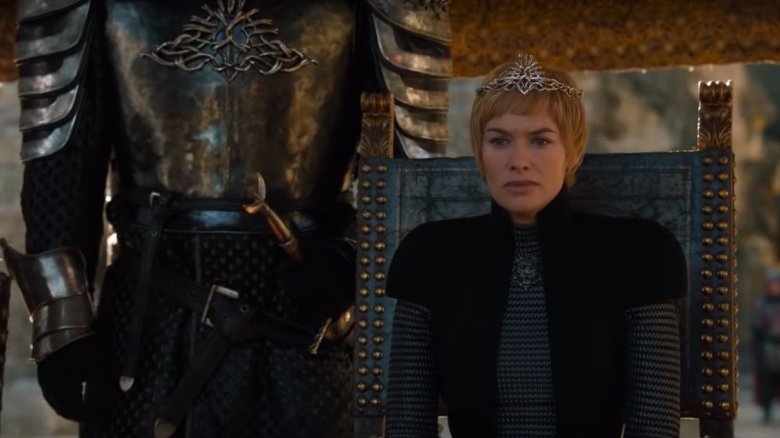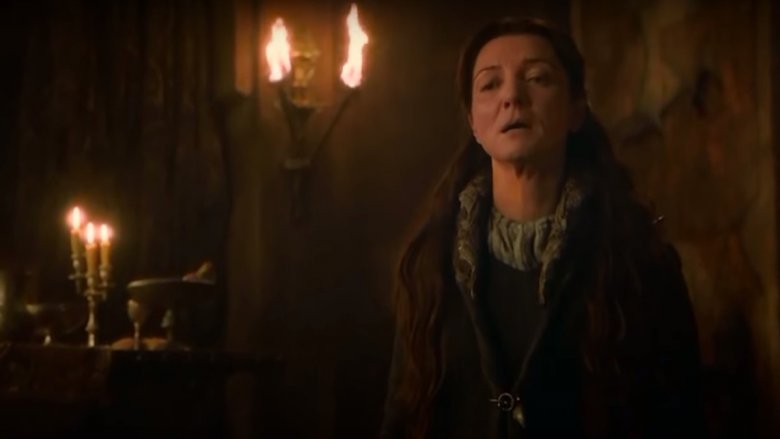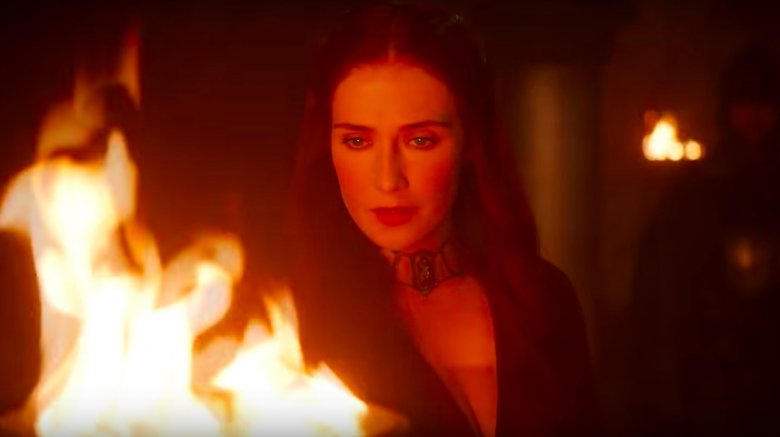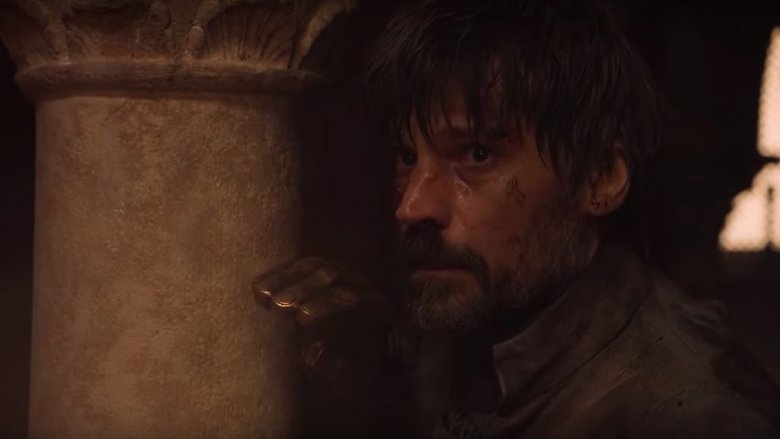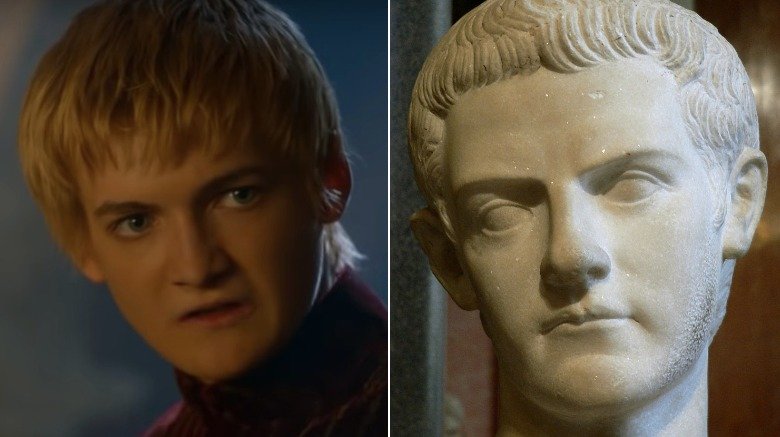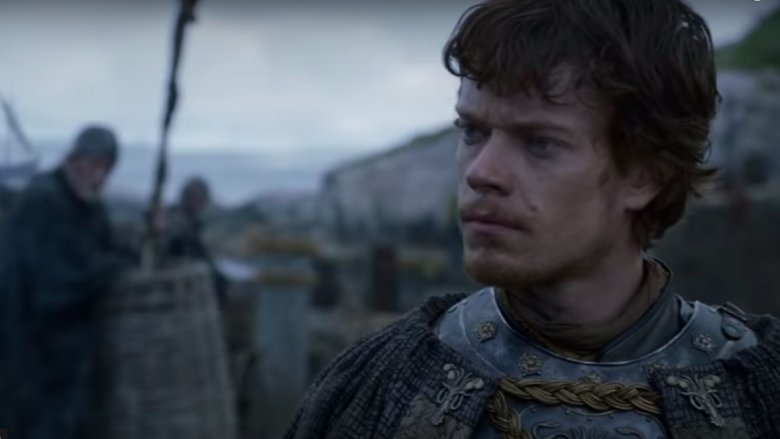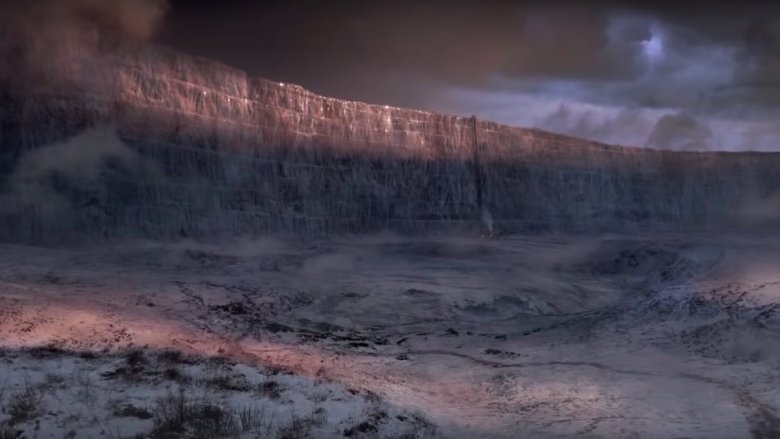The Real History Game Of Thrones Is Based On
Dragons, giants, White Walkers, and that weird thing Melisandre gave birth to in a cave — everyone knows it's all just fantasy, the invention of a mind that wants to amaze us, compel us, and piss us all off to the point where we're throwing things at our televisions. So it might be hard to get your mind around the idea that Game of Thrones isn't just pure fiction. In fact, George R. R. Martin — Father of Westeros, Killer of Favorite Characters, Wearer of the Fisherman's Cap, Haver of the Unnecessarily Excessive Initials — got a lot of his characters, story arcs, and actually the whole basic framework of the plot directly from history.
Now the good news is that we're mostly safe from White Walkers, wights, and Daenerys Targaryen because the fantastical elements of the story were George R. R. Martin's own invention. But it may interest you to know that many of the big bads of Westeros, and the heroes, too, were based on living, breathing people who made their own unique contributions to the history of our world, as well as to the history of the fictional world that's inspired us to break our expensive television sets and name our children after characters that went bat-poop crazy. So thanks, George, we love you. Sort of.
Also, this will contain Game of Thrones spoilers. Obviously.
The whole story is loosely based on the Wars of the Roses
Anyone with a rudimentary understanding of British history already knows there are parallels between Westeros and the Wars of the Roses. C'mon ... "Lancaster," "Lannister," it's not like it was thinly veiled or anything. If you're mostly unaware of what was happening in 15th-century England, though, we'll recap it for you. There were two royal houses — the Yorks and the Lancasters — and they both thought their guy was the rightful king, and a whole bunch of people died because of it.
According to the Guardian, the similarities between the real-life Wars of the Roses (which lasted three decades) and the war for the Seven Kingdoms goes beyond just the royal houses competing for the throne. The monarchs who ruled England during those tumultuous years were sometimes just as villainous as Cersei, as weak as Tommen, and as arrogant and delusional as Stannis. There were plots, bloody battles, so-called "protectors of the realm," and even a "Narrow Sea" in the English Channel. Now, obviously some facts have been altered so we can also have dragons and ice zombies in our story, but the basic framework was already in place, and it can be found in the boring old history book you never read. See? History does have value.
Tyrion Lannister is based on one of history's most notorious villains
History remembers Richard III as the hunchbacked villain staggering around the battlefield, crying out "My kingdom for a horse!" That's the way Shakespeare wanted us to remember him, probably because that's the way the Tudors wanted us to remember him. Shakespeare lived in a time where you could lose your head for displeasing the queen, and the queen was only sitting on the throne because her family dispatched Richard III at the Battle of Bosworth, so she kind of had a vested interest in making everyone think he was a bad, bad guy.
So you might be surprised to hear that Tyrion Lannister is loosely based on Richard III because Tyrion is not a villain; in fact some people argue that he's the show's primary protagonist. According to Den of Geek, though, Tyrion has some indisputable similarities to Shakespeare's infamous villain — he's a dwarf, and Richard III had scoliosis, a condition of the spine that made him short in stature. Like Tyrion, Richard fought for the common people — he even established a court that would give legal assistance to the poor. And like Tyrion, Richard's contemporaries believed his appearance reflected negatively on his character. No matter how many acts of heroism Tyrion engages in, you know, like saving King's Landing from Stannis Baratheon, he's never viewed as anything but an "imp."
Fun fact: Peter Dinklage actually played Richard III in a 2004 production of Shakespeare's famous play.
There really was a Red Wedding, except it was a different color and not exactly a wedding
As it turns out, Walder Frey wasn't the first guy who thought, "I should hold a feast in honor of my enemies and then kill them." That happened in history, too. George R. R. Martin heavily based the Red Wedding on an event from medieval Scotland, which also had one of those "bread and salt" traditions where you give salty baked goods to your guests as basically a symbolic guarantee that you aren't planning on killing them.
So that's cool, but medieval people weren't exactly known for being sticklers for rules or anything. Like the Freys, Scottish nobles would sometimes kill their own dinner guests. According to Entertainment Weekly, the specific story Martin based the Red Wedding on was known as "The Black Dinner," and it went down like this: The King of Scotland invited the earl of an enemy clan to his home as a gesture of peace. There was a great feast, and at the end of the feast the king's men started beating ominously on a drum, then they presented the earl with a black boar's head, which by the way is a symbol of death. Then they dragged him outside and executed him. Why all that dramatic stuff leading up to his execution? Um, unclear. Come on, King of Scotland, what do you think this is, Game of Thrones or something?
Daenerys Targaryen is based on the first Tudor king
Let's talk for a moment about Daenerys Targaryen, that strong female character we were all rooting for, who in the end turned out to be just a hysterical woman with a lethal weapon. Thanks, George, for giving the young women of the world a role model and then letting us all know how silly we were to think that women can handle power. Anyway.
According to Den of Geek, Daenerys is based largely not on a female character from history but on a very real male historical figure — Henry Tudor, who went on to become Henry VII, father of the notorious wife-killing crazyman we all know as Henry VIII.
Henry the VII defeated Richard III at the Battle of Bosworth (which was really nothing like the sack of King's Landing — the similarities are more in the backstory). Like Daenerys, Henry lived in exile, and like Daenerys, he crossed a "narrow sea" with a foreign army, which he used to win the battle and gain the throne. And also, the last thing Henry did to secure the throne was marry his third cousin, Elizabeth of York, which wouldn't be totally out of the question for Daenerys' character, since she was pretty cool with the idea of getting cozy with her own nephew. Although a peaceful ending wouldn't really sync with Martin's evident determination to alienate and disappoint everyone who's been watching for the last 10 years, so don't expect miracles.
The Lord of Light is based on an ancient Persian god
The Red Woman is by far the most morally ambiguous character in the entire show. She's clearly got the best interests of the realm at heart — she's intent on helping fulfill the prophecy of Azor Ahai and saving Westeros from the White Walkers, so points. She also burned a little girl at the stake, so minus points. We really don't know if we're supposed to love this chick or hate her.
The Red Woman follows the Lord of Light, who is presumably the guy who gives her the power to birth creepy shadow babies, bring people back to life, and look hot even though she's like a million years old. But the religion the Red Woman follows is not entirely made up — according to the Washington Post, Martin based it on the real-life Persian religion Zoroastrianism, which by the way was Freddie Mercury's religion, so you know, "burning through the sky ... Mr. Fahrenheit ... traveling at the speed of light" all makes a crazy kind of sense.
Seriously, though, both Zoroastrianism and the Lord of Light's faith have a belief in the purifying properties of fire and in the opposing forces of light and darkness, at least metaphorically. And in both religions there is a belief that good will rise up to defeat evil, just as Azor Ahai, who was apparently Arya Stark (who knew?) would rise up to defeat the White Walkers.
Jaime Lannister isn't the only famous guy with a metal hand
Even the ancient world had a version of the prosthetic limb, and we don't just mean peg legs for pirates. Whenever a culture engages in war with sharp objects, there are going to be people who lose limbs, and history even remembers some of them.
According to Bustle, Jaime Lannister's historical amputee-counterpart was Gotz von Berlichingen, a German knight who lost his hand in some weird cannonball-meets-sword incident during the siege of Landshut in 1504. And like Jaime Lannister, Gotz kept on fighting even after his hand was replaced by an iron prosthetic — in fact he had a couple prosthetics and could hold things like shields, reins, and even quills, so he was by no means a victim of his disability.
Jaime had another historical counterpart, too — his story also loosely parallels the story of the Italian nobleman Cesare Borgia. Like Jaime, Cesare took vows of celibacy which he just went ahead and broke anyway. And unlike Jaime, he was almost certainly not sleeping with his sister, though there are plenty of very loud rumors to the contrary.
The sack of King's Landing is reminiscent of the Dresden firebombing
It's impossible to compare the destruction of King's Landing in the penultimate episode of Game of Thrones to anything from ancient history because no one in ancient history had access to aerial weapons. According to the Atlantic, to find a historical parallel, you have to go forward in time — way forward, to the firebombing of Dresden in World War II, when Allied aircraft almost completely wiped out the German city. Whenever you wipe out a city, it's impossible to separate the innocent from the combatants, just as Daenerys was unable to spare the innocents in her quest to destroy her enemies (not that she really seemed to be trying to spare anyone at all).
Similarly, the bombings of the Japanese cities of Nagasaki and Hiroshima were equally merciless — when Dany said she was going to reserve all her mercy for "future generations who will never again be held hostage by a tyrant," it was remarkably similar to the justifications we heard for killing civilians in Japan: It was okay because it would end the war and ultimately save more lives than it cost.
We don't really know Dany's true motivation for sacking the city but it seems like it wasn't just the flipping of some mad queen switch. Like other historical figures, Daenerys likely believed that showing her strength would convince potential challengers to join the Repair-The-Wall Task Force instead of challenging her.
The Night's Watch is basically the Order of the Knights Templar, only colder
The only folks in Westeros who don't bother themselves with all the political nonsense going on in the rest of the Seven Kingdoms are the guys at Castle Black because let's face it, it's way too danged cold up there to think of anything except how freaking cold you are all the time.
Seriously, though, the Night's Watch has a couple of close historical parallels. In many ways, they're like the Roman legions who stood guard near Hadrian's Wall, but as far as the whole "noble order you can never leave" thing is concerned, they're more similar to the Knights Templar, who were originally just a small group of soldiers who protected travelers on the roads through the recently conquered Holy Land.
According to Vintage News, the Knights Templar were charged with keeping hooligans (the Wildlings) away from the "good people" of the world (the not-Wildlings). The Templars, which eventually grew into a much larger order with broader duties, sometimes came from noble families and were sometimes criminals who sought to redeem themselves through service to God. And the Templars also had to swear a vow of chastity and poverty, just like the men of the Night's Watch. They were not, however, forced to never, ever be warm again, so just like all of the histories Thrones is based on, the similarities aren't always complete.
Joffrey is totally Caligula, and probably some other guy, too
Who was the most sadistic character from ancient history? You'd have a hard time finding someone worse than Caligula, and if you put Caligula and Joffrey Baratheon side by side, oh wow, they're like psychopath twins! How adorable.
Like Joffrey, Caligula was totally unhinged. According to Ancient History Encyclopedia, he enjoyed watching executions and tortures, he was paranoid, and he had his own relatives executed. As far as we know, Joffrey never threatened to make his horse a consul, but he did have a Hound as his sworn shield, so you know, psychopath twins.
According to Persephone Magazine, Joffrey's character also has distinct similarities to Edward of Lancaster, another Wars of the Roses character who may or may not have been the son of a king. Edward was born eight years into his mother's marriage to Henry VI, and Henry was kind of cuckoo at that point so it seems doubtful that he was the boy's biological father. Like Joffrey, Edward was also a sadistic little creep, though not quite on par with Caligula. So really, they were more like fraternal psychopath twins, but still.
Theon Greyjoy's story parallels a tragic character from the Wars of the Roses
Poor Theon. Sure, he was a jerk during the early seasons of Game of Thrones, but the guy more than paid for his crimes when he met Ramsay Bolton and became the pathetic and deplorable Reek. Surely Theon's story wasn't based on anyone from history ... was it?
Well, as far as we know there was never a Reek, at least not a famous one, though it is certainly true that historical people were sometimes made into eunuchs so they would become more loyal servants. But according to History Behind Game of Thrones, Theon does have similarities to the Wars of the Roses character George Plantagenet. A rebellion separated both George and Theon from their fathers — Theon was sent to live with the Starks as a hostage/guest after his father rebelled against Robert Baratheon, while George became a hostage of the king after his father rebelled. Theon and George were both third sons who became their families' heirs through the deaths of the elder sons. And Theon and George both had to choose whether to fight for their brother or father. Both chose to betray their brothers.
Interestingly, drowning plays a role in the lives of both men — George Plantagenet was supposedly executed by drowning (in a vat of wine, so perks) and Theon was "reborn" when he was baptized in the name of the Drowned God. Tenuous, a little, but still worth a mention.
The Dothraki are unabashedly based on the Mongols
The first time you saw the Dothraki, you didn't say, "Hmm, where have I seen those guys before," you said, "oh, the Mongols." Because the Dothraki aren't just sort of similar to the Mongols, they're pretty much exactly like the Mongols. Their leader is a "khal," and the Mongol leader was a "khan," and also George R. R. pretty much said they were based on the Mongols, though he also said he added elements of the steppe tribes and American Indian plains tribes.
Still, Martin has been criticized for his portrayal of the Dothraki because they are kind of the stereotypical "noble savage," but he excuses the portrayal because he says it aligns with the true nature of the historical Mongols. "Even at the height of their sophistication they were fond of doing things like giant piles of heads," he told Gizmodo. "'Surrender your city to me, or we will come in and kill all the men, rape all the women, and make a giant pile of heads.'"
Well, that does sound an awful lot like the Dothraki.
The Wall is Hadrian's Wall, only colder
So after the Romans set up shop in great Britain they were all, "Wow those Northerners are crazy, we should build a wall or we are totally going to have to fight them." That's pretty much exactly what happened in Game of Thrones, too, only it was many years before the events we see in the show.
The Wall was built to keep out the White Walkers and the Wildlings, who live in the far northern end of Westeros, just like Hadrian's Wall was built to keep out the Picts, who lived in early Scotland. George R. R. Martin has said that the Wall of Westeros was based on Hadrian's Wall, but if you visit Hadrian's Wall today it's really sort of a pathetic shadow of its former self — a White Walker could just step over the thing, forget having it to knock it down with an ice dragon. According to English Heritage, though, Hadrian's wall originally topped out at 15 feet, a lot more formidable than it is today.

